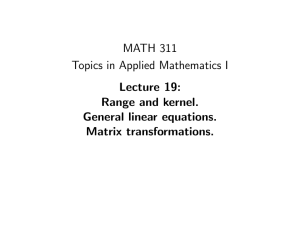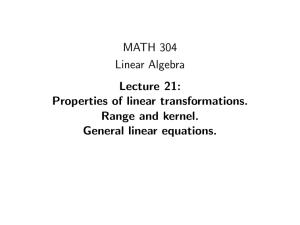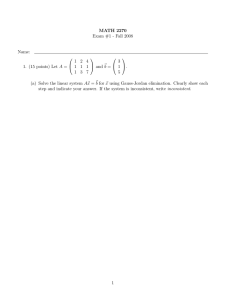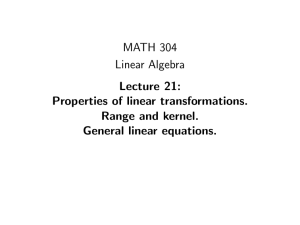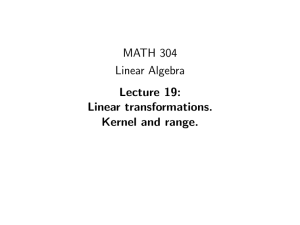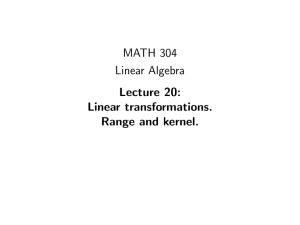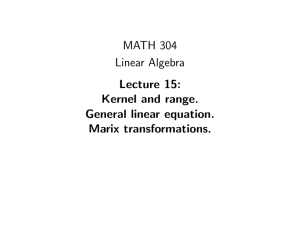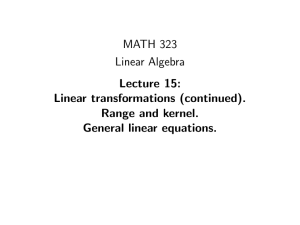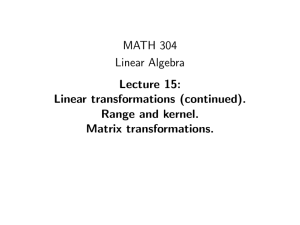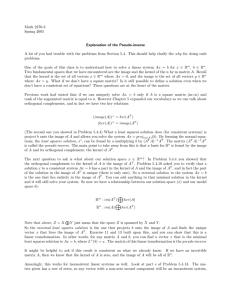MATH 304 Linear Algebra Lecture 21: Range and kernel.
advertisement
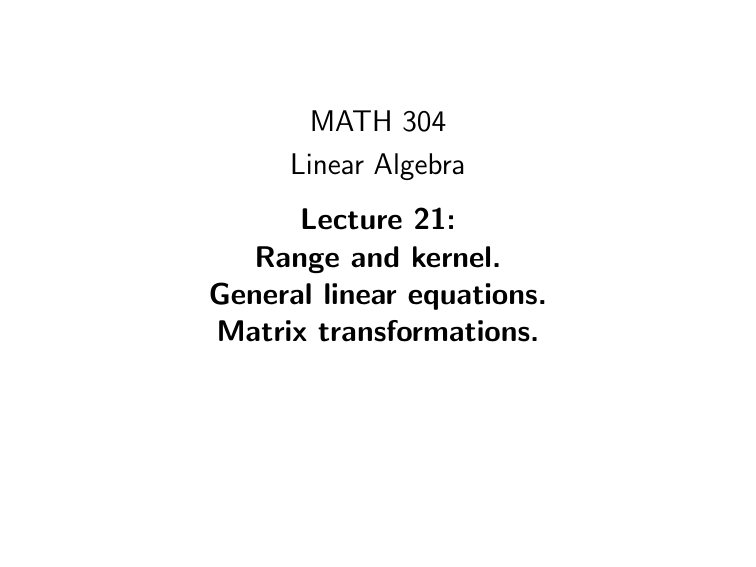
MATH 304 Linear Algebra Lecture 21: Range and kernel. General linear equations. Matrix transformations. Linear transformation Definition. Given vector spaces V1 and V2 , a mapping L : V1 → V2 is linear if L(x + y) = L(x) + L(y), L(r x) = rL(x) for any x, y ∈ V1 and r ∈ R. Basic properties of linear mappings: • L(r1 v1 + · · · + rk vk ) = r1 L(v1 ) + · · · + rk L(vk ) for all k ≥ 1, v1 , . . . , vk ∈ V1 , and r1 , . . . , rk ∈ R. • L(01 ) = 02 , where 01 and 02 are zero vectors in V1 and V2 , respectively. • L(−v) = −L(v) for any v ∈ V1 . Examples. Mm,n (R): the space of m×n matrices. • α : Mm,n (R) → Mn,m (R), α(A) = AT . α(A + B) = α(A) + α(B) ⇐⇒ (A + B)T = AT + B T . α(rA) = r α(A) ⇐⇒ (rA)T = rAT . Hence α is linear. • β : M2,2 (R) → R, β(A) = det A. 1 0 0 0 0 0 . 0 1 and B = 1 0 . Then A + B = 0 1 We have det(A) = det(B) = 0 while det(A + B) = 1. Hence β(A + B) 6= β(A) + β(B) so that β is not linear. Let A = Range and kernel Let V , W be vector spaces and L : V → W be a linear mapping. Definition. The range (or image) of L is the set of all vectors w ∈ W such that w = L(v) for some v ∈ V . The range of L is denoted L(V ). The kernel of L, denoted ker L, is the set of all vectors v ∈ V such that L(v) = 0. Theorem (i) The range of L is a subspace of W . (ii) The kernel of L is a subspace of V . x 1 0 −1 x Example. L : R3 → R3 , L y = 1 2 −1 y . z 1 0 −1 z The kernel ker(L) is the nullspace of the matrix. −1 0 1 x L y = x 1 + y 2 + z −1 −1 0 1 z The range L(R3 ) is the column space of the matrix. x 1 0 −1 x 3 3 Example. L : R → R , L y = 1 2 −1 y . z 1 0 −1 z The range of L is spanned by vectors (1, 1, 1), (0, 2, 0), and (−1, −1, −1). It follows that L(R3 ) is the plane spanned by (1, 1, 1) and (0, 1, 0). To find 1 0 1 2 1 0 ker(L), we apply row reduction to the matrix: 1 0 −1 1 0 −1 −1 0 0 → 0 1 −1 → 0 2 0 0 0 0 0 0 −1 Hence (x, y , z) ∈ ker(L) if x − z = y = 0. It follows that ker(L) is the line spanned by (1, 0, 1). Example. L : C 3 (R) → C (R), L(u) = u ′′′ − 2u ′′ + u ′ . According to the theory of differential equations, the initial value problem u ′′′ (x) − 2u ′′ (x) + u ′ (x) = g (x), x ∈ R, u(a) = b0 , u ′ (a) = b1 , u ′′ (a) = b 2 has a unique solution for any g ∈ C (R) and any b0 , b1 , b2 ∈ R. It follows that L(C 3 (R)) = C (R). Also, the initial data evaluation I (u) = (u(a), u ′ (a), u ′′ (a)), which is a linear mapping I : C 3 (R) → R3 , is one-to-one when restricted to ker(L). Hence dim ker(L) = 3. It is easy to check that L(xe x ) = L(e x ) = L(1) = 0. Besides, the functions xe x , e x , and 1 are linearly independent (use Wronskian). It follows that ker(L) = Span(xe x , e x , 1). General linear equations Definition. A linear equation is an equation of the form L(x) = b, where L : V → W is a linear mapping, b is a given vector from W , and x is an unknown vector from V . The range of L is the set of all vectors b ∈ W such that the equation L(x) = b has a solution. The kernel of L is the solution set of the homogeneous linear equation L(x) = 0. Theorem If the linear equation L(x) = b is solvable and dim ker L < ∞, then the general solution is x0 + t1 v1 + · · · + tk vk , where x0 is a particular solution, v1 , . . . , vk is a basis for the kernel of L, and t1 , . . . , tk are arbitrary scalars. x + y + z = 4, x + 2y = 3. x x 1 1 1 y . L : R3 → R2 , Ly = 1 2 0 z z 4 Linear equation: L(x) = b, where b = . 3 1 1 1 4 1 1 1 4 1 0 2 5 → → 1 2 0 3 0 1 −1 −1 0 1 −1 −1 x + 2z = 5 x = 5 − 2z ⇐⇒ y − z = −1 y = −1 + z Example. (x, y , z) = (5 − 2t, −1 + t, t) = (5, −1, 0) + t(−2, 1, 1). Example. u ′′′ (x) − 2u ′′ (x) + u ′ (x) = e 2x . Linear operator L : C 3 (R) → C (R), Lu = u ′′′ − 2u ′′ + u ′ . Linear equation: Lu = b, where b(x) = e 2x . We already know that functions xe x , e x and 1 form a basis for the kernel of L. It remains to find a particular solution. L(e 2x ) = 8e 2x − 2(4e 2x ) + 2e 2x = 2e 2x . Since L is a linear operator, L 12 e 2x = e 2x . Particular solution: u0 (x) = 12 e 2x . Thus the general solution is u(x) = 12 e 2x + t1 xe x + t2 e x + t3 . Matrix transformations Any m×n matrix A gives rise to a transformation L : Rn → Rm given by L(x) = Ax, where x ∈ Rn and L(x) ∈ Rm are regarded as column vectors. This transformation is linear. x 1 0 2 x Example. L y = 3 4 7y . z 0 5 8 z Let e1 = (1, 0, 0), e2 = (0, 1, 0), e3 = (0, 0, 1) be the standard basis for R3 . We have that L(e1 ) = (1, 3, 0), L(e2 ) = (0, 4, 5), L(e3 ) = (2, 7, 8). Thus L(e1 ), L(e2 ), L(e3 ) are columns of the matrix. Problem. Find a linear mapping L : R3 → R2 such that L(e1 ) = (1, 1), L(e2 ) = (0, −2), L(e3 ) = (3, 0), where e1 , e2 , e3 is the standard basis for R3 . L(x, y , z) = L(xe1 + y e2 + ze3 ) = xL(e1 ) + yL(e2 ) + zL(e3 ) = x(1, 1) + y (0, −2) + z(3, 0) = (x + 3z, x − 2y ) x x + 3z 1 0 3 y L(x, y , z) = = x − 2y 1 −2 0 z Columns of the matrix are vectors L(e1 ), L(e2 ), L(e3 ). Theorem Suppose L : Rn → Rm is a linear map. Then there exists an m×n matrix A such that L(x) = Ax for all x ∈ Rn . Columns of A are vectors L(e1 ), L(e2 ), . . . , L(en ), where e1 , e2 , . . . , en is the standard basis for Rn . y1 a11 a12 . . . a1n x1 y2 a21 a22 . . . a2n x2 . y = Ax ⇐⇒ .. .. ... ... = ... .. . . ⇐⇒ ym am1 am2 . . . amn xn y1 a11 a12 a1n y2 a a a . = x1 21 + x2 22 + · · · + xn 2n . . .. .. .. ... ym am1 am2 amn
